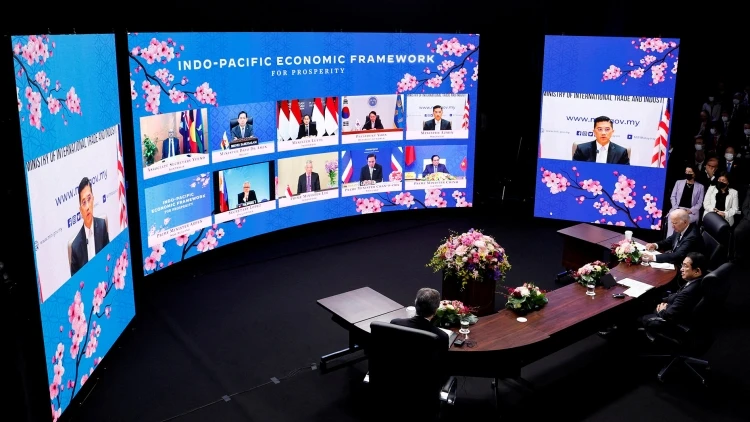
The participating countries included Australia, Brunei, Fiji, India, Indonesia, Japan, South Korea, Malaysia, New Zealand, the Philippines, Singapore, Thailand, and Vietnam. The relevance of this discussion is of great value as all of these thirteen economies combined are equivalent to 40% of GDP of the entire globe.
New economic platform
At the launch ceremony of the IPEF discussion, Prime Minister Phạm Minh Chính spoke online and emphasized the need to adjust the growth and economic integration model towards a more sustainable, more self-reliant, more resilient development; to also strengthen internal forces combined with optimization of external forces; and to develop multilateralism and strengthen international solidarity on the basis of sincerity, trust, and responsibility. According to the Prime Minister, this event will kick-start and encourage countries to work together to actively exchange and hold serious discussions to jointly handle important regional and global issues.
However, the question many people are asking is an understanding of what actually IPEF is and what challenges and opportunities does Vietnam face as one of the thirteen members involved in the discussions to establish a new economic framework.
The IPEF, initiated by the current administration of US President Joe Biden, is seen as an important platform for the development, growth, and security of an Indo-Pacific Strategy. This framework will focus on four key pillars for establishing the highest standards of commitment by all the countries involved.
The first pillar in focus will be commerce activities, which will include digital economy. The second pillar will be the crucial supply chain. The third pillar will be cleaner energy, reducing of carbon emissions, and infrastructure to promote higher paying jobs. The fourth pillar will be taxation methods and anti-corruption policies.
The US has been conducting several consultations with regional countries since the end of 2021 and this was not an easy process, although it is the regional countries, especially ASEAN, that have long asked the US to add an economic pillar with more focus on security. This was especially emphasized after the US withdrew from the Comprehensive and Progressive Agreement for Trans-Pacific Partnership (CPTPP) in early 2017 because of internal political issues.
At that time, the CPTPP was a trade agreement, so the negotiation and ratification process required approval at many levels, including the US Congress. Now if the executive branch wants to bring the US back to the CPTPP table, it will most likely face opposition from the Congress. While the IPEF is designed to be an executive body and placed under the authority of the President, the discussions and ratification processes will be more centralized.
In general, the four pillars of IPEF will offer reliability, sustainability, green and clean energy, and more focus on digitalization. All this is consistent with Vietnam's development plans for the future. Participating in this framework means that Vietnam is taking part at many levels of economic cooperation in the region and the world and complementing other partners in creating a driving force towards future development and growth, with a view towards sustainability and security.
Although IPEF is not yet a trade agreement like the CPTPP, it will open up new opportunities for countries to cooperate with the US, which is the world's leading economy. First of all, this platform will connect supply chains, new technology, green energy, and high-quality digital transformation. These are the strongest and most crucial economic sectors of the future.
In addition, the IPEF economic framework will show that the US prioritize engagement with the region, both economically and in terms of security. This will encourage the country corporations and the private sector to do more business and invest more in the region. Of course, the participating countries will also have to clarify, through the IPEF platform as to what the US will commit to opening its market.
Role of ASEAN
The IPEF platform involves seven countries in ASEAN, which means that the US wants to start this new economic framework with key countries in the Southeast Asian region. Compared to the CPTPP, the IPEF platform has a number of major economies involved such as India and South Korea. The countries participating in talks to establish this new economic platform will also share their own interests and will in all likelihood have different concerns.
Besides the opportunity offered by IPEF, there are also concerns about a domination of bigger players. For instance, China will likely perceive IPEF as a way for the US to gather more support of these countries in terms of economy, trade, and technology. Therefore, the appropriate behavior will be what ASEAN has applied, namely, to play with both sides, and take advantage of each side.
The launch ceremony to kick off discussions at the IPEF Economic Forum was a general consultation among countries who will enter into specific negotiations. This was an open initiative, which meant that other countries could be invited to join in later. This is very good for Vietnam to participate in the consultation process right from the very beginning, as it will contribute to shaping the rules of IPEF, taking advantage of appropriate and different initiatives, including the CPTPP and Regional Comprehensive Economic Partnership Agreement (RCEP) between ASEAN and China, South Korea, Japan, India, Australia, and New Zealand.
IPEF has both geo-economic and geo-strategic value, which countries need right now and can take advantage of. However, this is just the beginning, and it will take time to gain in momentum as an effective and valuable Economic Framework.




















